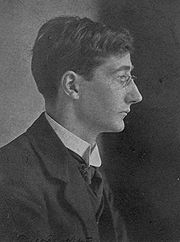
Lennox Robinson
Encyclopedia

Ireland
Ireland is an island to the northwest of continental Europe. It is the third-largest island in Europe and the twentieth-largest island on Earth...
dramatist, poet
Poet
A poet is a person who writes poetry. A poet's work can be literal, meaning that his work is derived from a specific event, or metaphorical, meaning that his work can take on many meanings and forms. Poets have existed since antiquity, in nearly all languages, and have produced works that vary...
and theatre
Theatre
Theatre is a collaborative form of fine art that uses live performers to present the experience of a real or imagined event before a live audience in a specific place. The performers may communicate this experience to the audience through combinations of gesture, speech, song, music or dance...
producer and director who was involved with the Abbey Theatre
Abbey Theatre
The Abbey Theatre , also known as the National Theatre of Ireland , is a theatre located in Dublin, Ireland. The Abbey first opened its doors to the public on 27 December 1904. Despite losing its original building to a fire in 1951, it has remained active to the present day...
.
Robinson was born in Westgrove, Douglas in County Cork and raised in a Protestant and Unionist family in which he was the youngest of seven children. His father, Andrew Robinson, was a middle-class stockbroker who in 1892 decided to become a clergyman in the Church of Ireland
Church of Ireland
The Church of Ireland is an autonomous province of the Anglican Communion. The church operates in all parts of Ireland and is the second largest religious body on the island after the Roman Catholic Church...
in the small Ballymoney parish, near Ballineen in West Cork. A sickly child, Robinson was educated by private tutor and at Bandon Grammar School
Bandon Grammar School
Bandon Grammar School is a secondary school situated in Bandon, Co Cork, Republic of Ireland. It is primarily a Church of Ireland school. Its current principal is David Sutton.- Official School Message :...
. In August 1907, his interest in the theatre began after he went to see an Abbey production of plays by W. B. Yeats and Lady Gregory at the Cork Opera House
Cork Opera House
Cork Opera House is a theatre and opera house in Cork in the Republic of Ireland. It was originally built in 1855, although its existence has not been continuous; having survived the burning of much of Cork by British forces in reprisal for an ambush of a military convoy in 1920 by Irish rebels,...
. He published his first poem that same year. His first play, The Cross Roads, was performed in the Abbey in 1909 and he became manager of the theatre towards the end of that year. He resigned in 1914 as a result of a disastrous tour of the United States but returned in 1919. He was appointed to the board of the theatre in 1923 and continued to serve in that capacity until his death.
As a playwright, Robinson showed himself as a nationalist with plays like Patriots (1912) and Dreamers (1915). On the other hand, he belonged to a part of Irish society which was not seen as fully Irish. This division between the "pure" Catholic
Catholic
The word catholic comes from the Greek phrase , meaning "on the whole," "according to the whole" or "in general", and is a combination of the Greek words meaning "about" and meaning "whole"...
Irish on one side and the Anglo-Irish
Anglo-Irish
Anglo-Irish was a term used primarily in the 19th and early 20th centuries to identify a privileged social class in Ireland, whose members were the descendants and successors of the Protestant Ascendancy, mostly belonging to the Church of Ireland, which was the established church of Ireland until...
on the other can be seen in a play such as The Big House (1926), which depicts a burning of such a Protestant manor by Irregulars, or extreme Republicans.
Robinson's most popular play was The Whiteheaded Boy (1916). Other plays included Crabbed Youth and Age (1924), The Far Off Hills (1928), Drama at Inish
Drama at Inish
Drama at Inish is a comic play by the Irish writer Lennox Robinson which was first performed at the Abbey Theatre, Dublin on 6 February 1933. The storyline of the play serves as a parody of the plots and atmosphere of the plays being performed within it....
(1933), and Church Street (1935). Drama at Inish, which was presented in London and on Broadway as Is Life Worth Living?, was revived as part of the 2011 season at the Shaw Festival (Niagara-on-the-Lake, Ontario, Canada), with Mary Haney as Lizzie Twohig. Robinson's fiction includes Eight Short Stories (1919). In 1931 he published a biography of Bryan Cooper
Bryan Cooper
Bryan Cooper may refer to:*Cooper , aka Bryan Cooper, American artist*Bryan Cooper , Irish independent/Cumann na nGaedhael politician*Brian Cooper, baseball player...
, who had recently died. In 1951, he published Ireland's Abbey Theatre, the first full-length history of the company.
Robinson was married to the daughter of spiritualist Hester Dowden
Hester Dowden
Hester Dowden , or Hester Travers Smith, was an Irish spiritualist medium who is most notable for having claimed to contact the spirits of Oscar Wilde, William Shakespeare and other writers. Dowden's spirit-communications were published by various authors...
, herself daughter of the Irish literary scholar Edward Dowden
Edward Dowden
Edward Dowden , was an Irish critic and poet.He was the son of John Wheeler Dowden, a merchant and landowner, and was born at Cork, three years after his brother John, who became Bishop of Edinburgh in 1886. Edward's literary tastes emerged early, in a series of essays written at the age of twelve...
.
External Links
- Lennox Robinson Papers, 1892-1954 at Southern Illinois University Carbondale, Special Collections Research Center

